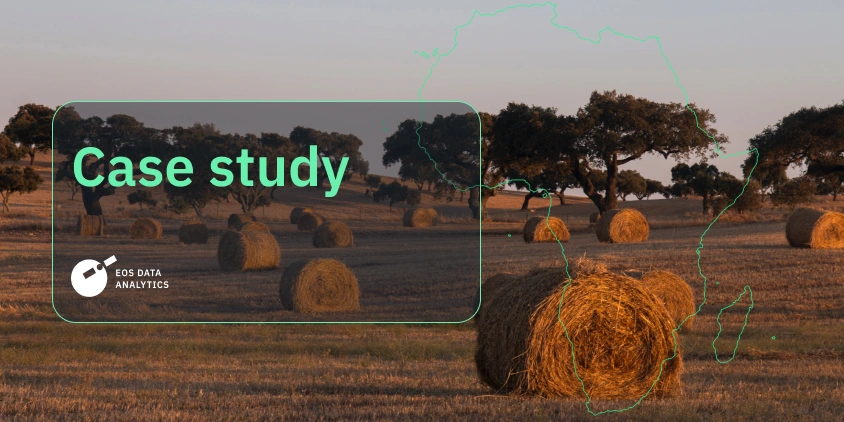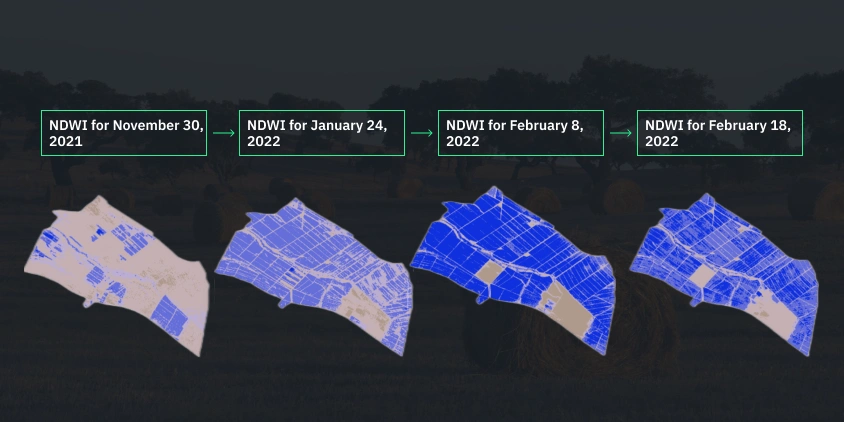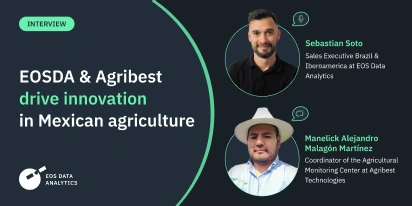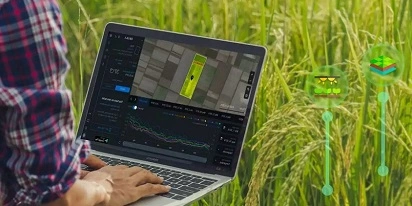
How EOSDA Helps Improve Farming In West Africa
Agriculture remains a cornerstone in Africa’s quest for economic growth and social development. Sub-Saharan Africa, a region of vast potential, is grappling with significant challenges that hinder its agricultural and economic progress. Amidst these challenges, the continent’s economic growth was expected to decelerate to 2.5% in 2023, down from 3.6% in 2022, largely due to increased fragility, conflicts, and the adverse effects of climate change . This slowdown highlights the urgent need for innovative solutions to drive agricultural productivity and economic resilience.
Addressing these challenges, one company’s strategic adoption of EOSDA Crop Monitoring, an online satellite-based precision agriculture platform for field monitoring created by EOS Data Analytics, illustrates a forward-thinking approach to enhancing agricultural productivity. By leveraging the platform’s advanced satellite analytics, the company has not only streamlined its operational processes but also significantly contributed to improving crop yields.
Overview: About A Premier Wheat Miller In Africa
One leading international agribusiness entity specializes in offering an array of natural food products and ingredients, playing a pivotal role in the global supply of food, feed, and fiber. As one of the largest distributors and merchants of rice and cotton, coupled with its distinction as the premier wheat miller in Western Africa, it marks a significant footprint across the industry.
Within Nigeria, this organization operates a fully mechanized agricultural venture spanning thousands of hectares of farmland. This venture is distinguished by its ability to produce two crop cycles annually, significantly contributing to the nation’s food supply. Moreover, it plays a crucial role in combating unemployment, offering work to a wide array of individuals, encompassing both skilled and unskilled labor. This way, the company shows its commitment to agricultural excellence and fostering socio-economic growth.
Challenges: Sustainable Rice Cultivation, Insufficient Satellite Data
When it comes to rice cultivation, where meticulous organization and precision are paramount, one unpredictable element remains beyond control: the whims of nature.
Weather conditions, from droughts and excessive rainfall to extreme temperatures, pose a significant challenge to rice production. Given rice’s susceptibility to such environmental stresses and its fixed maturation period of 105–120 days, the stakes for timely and accurate agricultural responses are incredibly high. Issues such as crop diseases, nutrient deficiencies in plants, and pest attacks must be identified and addressed promptly. The necessity for information from the fields to be nearly real-time is crucial, ensuring that no critical moment for evaluating and enhancing the crop-growing process is missed.
The company’s initial efforts to analyze satellite imagery were marked by inefficiency and a significant consumption of time. The challenge was compounded during the rainy season, from May to October, when accessing cloud-free satellite images — an essential resource for the company’s informed decision-making — became even more difficult. This period is critical for rice farming operations, highlighting the need for a more effective solution to forecast weather impacts and ensure a resilient and productive agricultural practice.
EOSDA Crop Monitoring
Using satellite monitoring for remote fields management in one platform!
Solution: Satellite Analytics For More Informed Decisions
To overcome the challenges posed by unpredictable weather conditions and the inherent limitations of traditional satellite imagery analysis, the decision was made to integrate the EOSDA’s agriculture platform.
This solution caused a significant advancement in the company’s processes, providing ready-to-use data processed through mathematical algorithms and delivering both recent and historical insights into farmlands. This improvement has drastically reduced the time required for data analysis, enabling specialists to access field images and analytics swiftly, thus facilitating timely decisions regarding crop management.
Central to the platform’s utility are its vegetation indices, which offer a comprehensive 360-degree view of crop health and conditions. These indices have helped in prioritizing the needs of agricultural practices and enhancing the company’s decision-making processes related to irrigation, fertilization, and overall crop management.

The company’s most utilized indices are:
- NDVI (Normalized Difference Vegetation Index): Essential for monitoring crop health and assisting in precision agriculture practices such as optimal irrigation and fertilization.
- NDWI (Normalized Difference Water Index): Crucial for identifying water bodies and managing irrigation efficiently, ensuring the right amount of water is applied to the crops.
- MSAVI (Modified Soil Adjusted Vegetation Index) and EVI (Enhanced Vegetation Index): These indices come into play for early seed growth monitoring and in areas with dense vegetation, respectively, providing critical data for informed agricultural decisions.

The integration of these indices has led to marked improvements in crop health and productivity, especially in areas previously challenged by adverse conditions. The platform has enabled a detailed tracking of vegetation health through NDVI dynamics and offered insights into historical field productivity, allowing for a more informed and strategic approach to crop management.
Outcome: Leap In Efficiency And Production Expansion
The implementation of EOSDA Crop Monitoring has catalyzed a transformative shift in agricultural practices, resulting in substantial operational efficiencies and enhanced crop yields. By reducing the time required for downloading and processing satellite images from open sources by over 80%, the platform’s provision of ready-to-use satellite images has streamlined integration into existing systems. This leap in efficiency was achieved through the availability of satellite imagery in formats conducive to immediate application and analysis.
This strategic use of satellite data has empowered specialists to make smarter, quicker decisions based on actual field data, leading to a significant increase in productivity. Over the last few years, this approach has facilitated a yield growth from 3.8 to 4.5 tonnes of rice per hectare, marking a notable improvement in agricultural output.
In the wake of these advancements, there is an ongoing effort to expand meal production capacities, including the processing of own-produced rice and the procurement of additional paddy from local farmers. This endeavor is part of a broader strategy to enhance agricultural capacity and deliver an increased volume of high-quality grain to the market.
This case study reveals the technological efficacy that EOSDA Crop Monitoring enables for its clients, allowing them to commit to sustainable agricultural practices that bolster both local economies and global food supply chains.
About the author:
Maksym Sushchuk is at the forefront of realizing EOSDA's vision to make space tech a global driver of sustainability on Earth. He has over 15 years of experience in journalism and content creation for prominent Ukrainian startups, charitable funds and ESG businesses. As Head and Co-founder of PR Army Maxim brings attention to the human and social tolls of the aggression against Ukraine.
Recent articles

Transition Guide From Sentinel Hub EO Browser To EOSDA LandViewer
Need an EO Browser alternative that’s just as familiar but more flexible? EOSDA LandViewer offers free recent imagery, a vast satellite data archive, and advanced analytical tools.

EOSDA & Agribest: Driving Agtech Growth In Mexico
In this insightful interview, Agribest shares how its collaboration with EOSDA is shaping Mexico’s agricultural future, with a focus on profitability, sustainability, and technology.

Top Ready-Made Agriculture Tools & Softwares for 2025
Agriculture softwares are silent partners in the field, working tirelessly behind the scenes to support farmers with insights and precision to cultivate sustainable agricultural ecosystems.